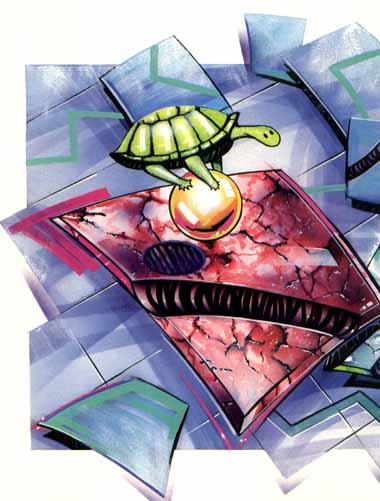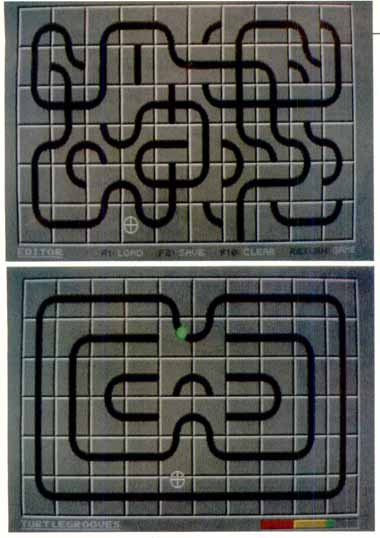
BY
GREG KNAUSS

Turtle Grooves is a simple game where the object is to keep colored marbles rolling along notches in tiles by rotating the tiles with the mouse-at least it sounds simple. But Turtle Grooves can become nerve-wracking as you skitter across the screen trying to keep three moving balls on wildly misshapen tracks.
Playing
the Game
When
the title screen comes up, press Escape to exit to the desktop, or the
space bar to start the game. When you begin, a box will appear, asking
which screen (set) you want to start with. You may choose any set you
have already reached, so if this is your first game of the day, you
must begin on set one. Pressing the mouse button from the title page
will always start you on set one.At the beginning of each new set, you are given a grace period in which you can rotate any tiles on the board, even the ones the marbles are on. Once the balls begin rolling (when the three-color counter at the lower right of the screen reaches zero), you will not be able to spin the tiles that have marbles on them.
To spin a tile, position the cursor over it with the mouse and click either mouse button, the right one rotating a tile right, the left one left. To finish a set, a marble must have rolled over every tile on the board, pushing it down. Once you complete a set, the next one will be put on the screen and your grace time will be shorter.
After a few sets, a second marble will join the first, and a few sets after that, a third will join the first two.
The
Editor
From the title screen you can press Return to enter
the Turtle Grooves editor, where you can alter existing tracks or add
your own.While in the editor, position the cursor over a tile and press either mouse button. You can cycle through all the different tile types this way and build your own tracks.
Press F1 to load an existing set. Use the arrow keys to select the set number you want and press Return to load it. Escape aborts this operation.
Press F2 to save the set you are working on. Like loading, use the arrow keys to select the set number you want to save the current screen as. You will be allowed to select a number that is one past the last set on the disk to add this track onto the end of the existing ones.
F10 will clear the screen of the current set, and Return will take you to the title screen of the game.


Conclusion
It
takes a little practice to become proficient at Turtle Grooves, but
once you play it a few times, you'll start to recognize patterns and
learn the best tile-rotating strategies to use. Keep those balls
rolling! 
Greg Knauss is not 21, not attending the University of California, San Diego, and not telling the truth.